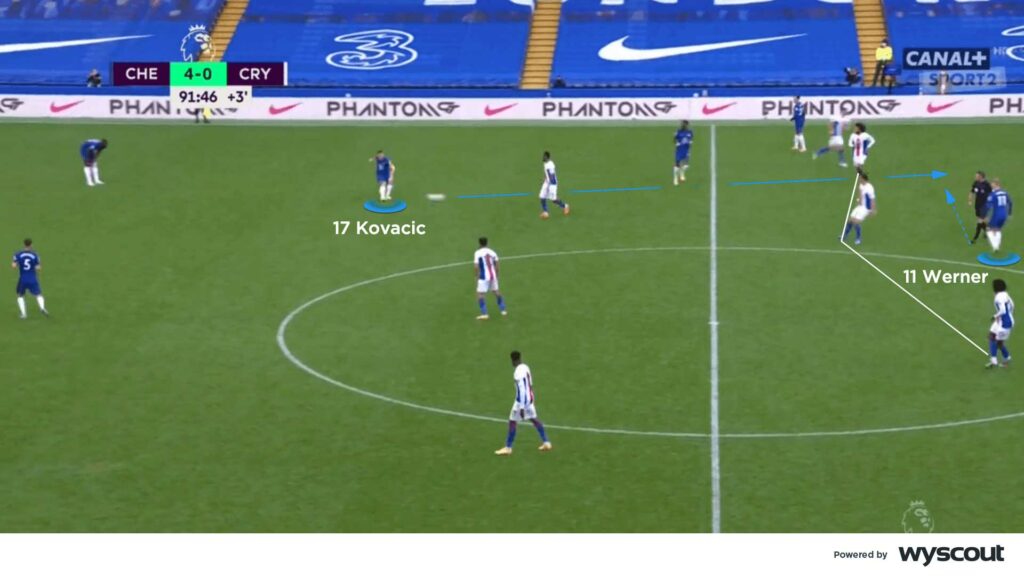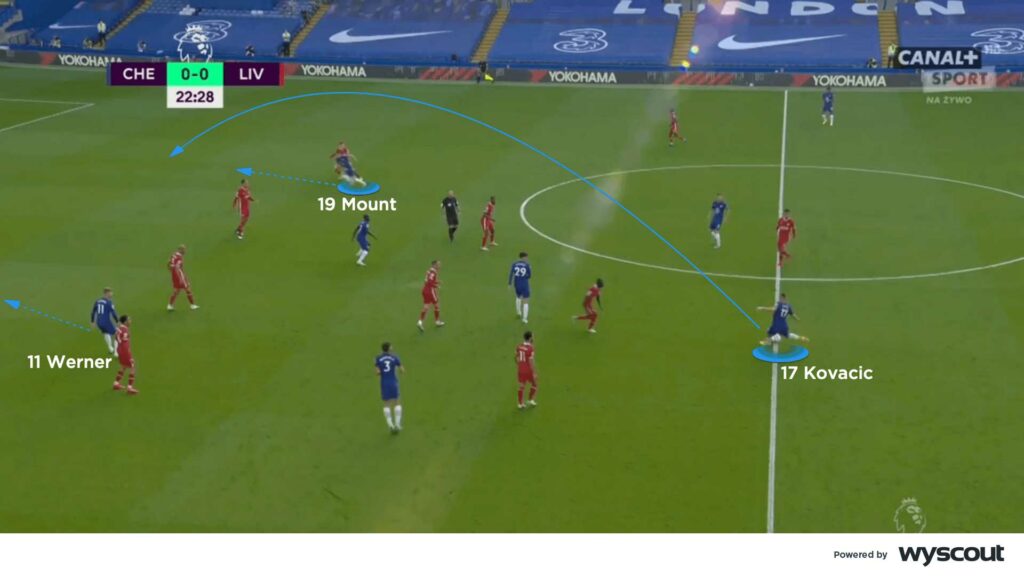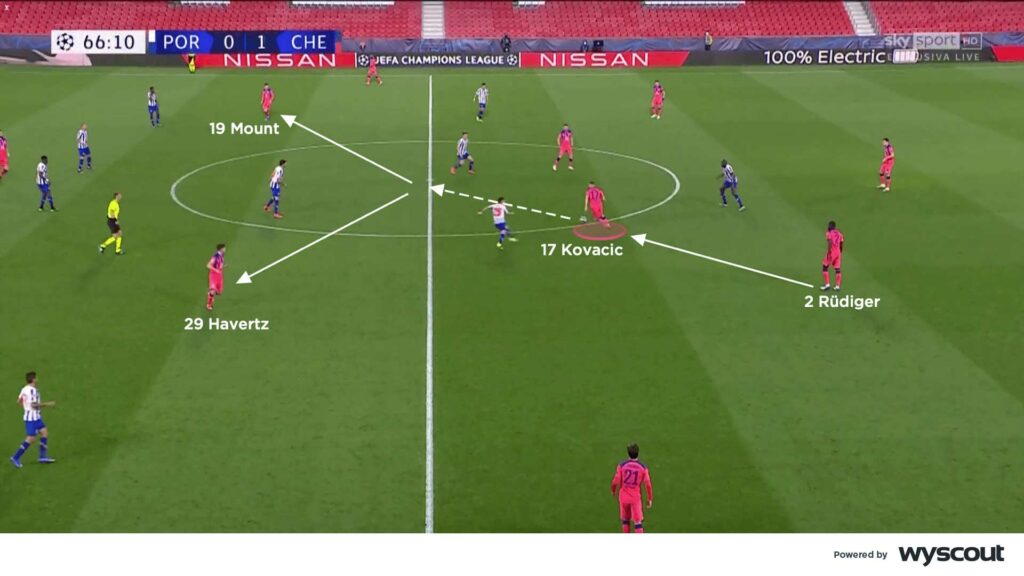
Mateo Kovacic
Chelsea, 2018–2023
Profile
Since his £40m move from Real Madrid, Mateo Kovacic has played a key role for Chelsea under three different managers in a variety of systems. Maurizio Sarri, Frank Lampard and Thomas Tuchel have all shown faith in the Croatian, who has adapted impressively to the different demands of each coach. Comfortable in possession, extremely hard working and a willing ball-winner, there is little he can’t do, so it should perhaps be little surprise that all three managers have thought so highly of him.
“We miss Kovacic when he doesn’t play,” Tuchel said when the midfielder was absent through injury. “He is a big loss, with his ability to drive with the ball, his speed on the ball, without the ball. Kova is such a positive character and unique player – a fighter who you can always rely on in games.”
Tactical analysis
Kovacic is a central midfielder who operates best as part of a three, though he has also shown he is capable of playing in a double pivot – as he has since Tuchel's appointment in January 2021. Despite being right-footed, he is most effective when operating from the left of a three, when he is supported by a single pivot and has the freedom to break forwards. His passing and movement in the inside left channel help him to break lines and create chances for his teammates, and from those positions he combines effectively with a lone striker and left-sided forward.
He possesses a superb work ethic – something that allows him to also play in a midfield two – and is both reliable and effective at defensive transitions, when he is switched on and alert to the space he needs to cover immediately after a turnover. He makes quick recovery runs so that his team regains its out-of-possession shape as swiftly as possible after losing the ball, and he is capable of bold, last-ditch tackles that can rescue his team when an opponent gets the wrong side of midfield.
When in possession Kovacic is a tidy player who is comfortable keeping the ball in tight areas. Disguised flicks away from danger are a trademark, but he can also dribble his way out of pressure, which is particularly useful when he is pressed in the defensive third of the pitch. His athleticism – and by extension his acceleration over short distances – coupled with good close control helps him to find his way out of difficult situations.

Perhaps Kovacic’s greatest strength, however, is that he looks to play vertically as much as possible. When there is an opportunity to play forwards, he takes it, either through a fast, accurate pass to break the opposition's midfield line (above) or via a dribble and a burst of pace. His dribbling ability means opponents often sit off him, reluctant as they are to get too close and risk him skipping past them and leaving another teammate exposed.
When Kovacic moves into deeper positions to collect the ball and he isn't pressured, because of an opponent's fear of being dribbled past, he is adept at playing clipped balls over the opposition or into wide positions (below). He is also comfortable retaining and recycling possession, and moving the ball across midfield quickly to change the point of attack. He favours staying in front of the opposition's midfield and influences play by moving the ball into attacking areas rather than receiving between the lines, but the consistency with which he looks to play progressive passes means he stands out from many other central midfielders.
There are regardless weaknesses to Kovacic’s game. He is not as strong in the air as someone of his height and build possibly should be – meaning that when he plays alongside someone like N’Golo Kanté there is little aerial dominance in Chelsea's midfield – and he is also sometimes prone to keeping hold of the ball for too long in midfield. He has been caught in possession more often than he should be, leading to turnovers in potentially dangerous positions, though that is something that he has clearly worked to improve. His shooting is another weakness. He regularly gets into a position on the edge of the area to receive a square ball or cut-back but is unconvincing with his shots, often putting them over the bar if he tries to put too much power behind them. When he does hit the target, he has usually used his instep, so his shot is too weak to beat the opposing goalkeeper.

Role at Chelsea
Under both Sarri and Lampard, Kovacic consistently started on the left of the midfield three in a 4-3-3, though a sharing of duties – first with Ross Barkley and then Mason Mount – meant that his game time was limited under both managers. He has, however, along with Kanté, Jorginho and Saúl Ñíguez become one of the four first-choice central midfielders under Tuchel – Tuchel favouring a 3-4-2-1 means that there are only two starting central midfield positions to compete for.
Kovacic will never be a central midfielder who just sits in front of defence, so when he plays – usually alongside Kanté – Chelsea have two driving forces who work extremely hard and cover an awful lot of ground. Both players push the team forwards via powerful surges with the ball, though it is Kanté who has greater freedom to attack. The Frenchman makes lung-busting runs beyond their attacking three; Kovacic stays in deeper positions to recycle play through. Kovacic is far more mobile than Jorginho, though, and will happily dribble forwards at pace or follow a forward pass with a run to receive a return ball. There is, as a result, less security to Chelsea’s shape when Kovacic and Kanté play together, but variety to their play overall as the two central midfielders constantly swap positions.

While Jorginho provides press resistance with his passing, Kovacic posts consistently high dribbling numbers, and helps Chelsea to play out from defence with a combination of impressive dribbling and daring, forward-thinking passes. He is extremely useful, in that regard, at both ends of the pitch – his ability to beat an opponent or eliminate defenders from play with positive, vertical passes is key in helping his team progress up the pitch quickly or break through an opposition's block. In the same way Mousa Dembélé did at Tottenham and David Silva did at Manchester City, Kovacic can give his team a potentially crucial numerical advantage in a central position by dribbling past an opponent (above).
He is a combative midfielder, and he makes plenty of tackles – though unsurprisingly, not as many as Kanté – and he plays a key defensive role in a midfield two that is tasked with protecting a back three. When Chelsea are trying to break down a deep defensive opponent, Kovacic and his midfield partner provide security in midfield in an in-possession 3-2-5, and when they drop back, he is effective at keeping space between the lines to a minimum in their 5-2-3.
A technically gifted, tenacious and tactically astute box-to-box midfielder, Kovacic is reliable rather than spectacular, but he has nonetheless become a key member of Chelsea's improving team. There is very good reason that three different Chelsea managers have valued him so highly.



